“The question of questions for mankind — the problem which underlies all others, and is more deeply interesting than any other — is the ascertainment of the place which Man occupies in nature.”
-Aldous Huxley
"We like to think that we base our beliefs on evidence, but some may notice that far more often we arrange the evidence to fit our beliefs. Distorting or excluding what won't fit, seeking out evidence that will, and surrounding ourselves with others who affirm them"
-Charles Eiseinstein in The More Beautiful World Our Hearts Know Is Possible

Hybrid - derived from latin hybrida, a variant of ibrida, meaning an offspring of a tame sow and a wild boar. Of unknown origin but likely Greek and somehow related to hubris. 1
This is a messy topic. It hasn't been discussed much or and certainly not discussed well. It's messy biologically, it's messy sociologically, it's messy taxonomically and perhaps worst of all, it's messy emotionally(maybe most of all for people with professional reputations dependent on being right).
Thus, let us start simple. Hybrids. We all know hybrids are a thing.
Ligers are a cross between a lion and a tiger.
Mules. Horse x Donkey
Zebroids. Zebra X any other equine
Cama. Camel x Llama
Geep. Sheep x Goat
Wholphin. False Killer Whale x Dolphin
Coy-Wolves. Wolfs x Coyotes x Dogs
These are only a few of the more well documented ones. So, how come this works? What a great question!! The short answer is, we don't know, but it does.
Yes, they are, moreover that is actually the definition of a species...a group of similar individual beings that are capable of exchanging genes. So by that definition Camels and Llamas are actually the same species? Hmmm, does anyone else starting to get the feeling that we're using an outdated set of models here?
So, where exactly did the word species come from to begin with?
14c as a classification in logic, from latin species 'a particular sort, kind, or type', from specere 'to look at, to see, to behold', from Proto-Indo-European spek; to observe.
It appears though our forebears using the word to classify or group things based upon their observations. Great. Let us then, not stop observing :P and continue on, we have a ways to go yet.
A ring species is a certain phenomena where we again see the concept itself of species fraying along the edges. Ensatina salamanders are an example. They live around the edges of the central valley in California, but not in the center of the valley.

Note the habitat does not connect around the southern tip of the valley, thus it's not quite a complete circle, more like a circle with a bite taken out of one side(in this case the bottom). When scientists began studying these salamanders at first it was thought that there were several different species, and they observed that the salamanders on one side of the valley were largely unable to reproduce with salamanders on the other side.
Fast forward several more decades of research(and observation!), and we've realized that if you take two salamanders from a similar area along any point of the ring, they can typically breed just fine, despite their markings. Yet, two salamanders from opposites ends of the ring, and it doesn't work. YET...those same two salamanders are still exchanging genes that end up traveling through the entire length of the ring, hopping from close neighbor to close neighbor.
Well..as you may be beginning to realize, that's a looking like a more and more useless question, there can be as many species as we like :P But that mostly just exists in our heads. The salamanders will still be salamandering along in a tidal wash of cross species genes surfing around the central valley.
I only bring all this up to attempt and illustrate a little thing that I think is very important to remember at the bottom of all this.
or in a different way
A coyote is not a coyote. You are not a human. Symbols. Representative. That's it...a word, a symbol represents something, it is not actually that thing. In this way, let us try to avoid falling in the trap of believing our symbols, and not actually, truly observing.
I have absolutely no fucking clue. I just came here to babble and pretend like I have friends
Just kittying. I'm realizing that in trying to write this damn story for the last week, I am finding myself caught up in trying to LOGIC it, or to ORCHESTRATE it beautifully or some shit...I care a lot about trying to convey this convincingly, cohesively, and effectively. But who the fuck am I kidding? You're probably drunk, or strung out on too much Steemit, sucking down information at an alarming rate.
You know, whatever! Either you're going to read this thing and be like "Holy Fuck, that shit is crazy, and wow, human noses sure do look funny now" or, you're one of those people that can't read anything longer then a paragraph already anyway, thus it doesn't actually matter what I write here.
Gee Itchy, don't you think that if we had descended from an ancestor of modern day pigs, that science would know this by now?
Yes, actually. I would think.
Alright, lets start getting specific. I've been reading Gene McCarthy's work, which is thoroughly documented on his website. And who knows?!! Maybe he just convinced me to join his cult or whatever...but fucking hell, how could the scientific community not explore this? How could we are humans not see it? How daft can we possibly be?
Right, the theory. I am going to let Gene start us off.
So why do I think humans are hybrids? Well, first of all, I’ve had a different experience from most people. I’ve spent most of my life (the last thirty years) studying hybrids, particularly avian and mammalian hybrids. I’ve read thousands of reports describing them. And this experience has dispelled some mistaken ideas I once had about hybrids, notions that I think many other people continue to take for granted.
For example, one widespread, but erroneous, belief is that all hybrids are sterile. This idea keeps a lot of people from even considering the possibility that humans might be of hybrid origin. The reality, however, is something quite different. For instance, in reviewing the reports I collected for my book on hybridization in birds, which documents some 4,000 different kinds of hybrid crosses among birds, I found that those crosses producing partially fertile hybrids are about eight times as common as crosses known to produce sterile ones. The usual result is a reduction in fertility, not absolute sterility. My current work documenting hybridization among mammals shows that partially fertile natural hybrids are common, too, in Class Mammalia. And yet, it seems most people base their ideas of hybrids on the common mule (horse x ass), which is an exceptionally sterile hybrid, and not at all representative of hybrids as a whole.
I should, perhaps, also mention that differences in parental chromosome counts, even rather large ones, do not preclude the production of fertile hybrids. While differences of this sort do bode ill for the fertility of the resulting progeny, it is only a rule of thumb. For example, female geeps, the products of hybridization between sheep (2n=54) and goats (2n=60), can produce offspring in backcrosses. Likewise, female zeedonks (Burchell’s Zebra, 2n=44 x Ass, 2n=62) have also been fertile in backcrosses. There are many other examples of this sort among mammalian hybrids. Therefore, such differences between the parents in a cross do not in any way guarantee an absolute sterility in the hybrid offspring. (For those readers who do not know, backcross hybrids are produced when hybrids from a first cross mate with either of the two types of parents that produced them. When the resulting progeny mate again with the same parental type, the result is the second backcross generation, and so forth.)
A second so-called fact, which might make it seem impossible for humans to have had a hybrid origin, is the equally erroneous notion that hybrids, especially successful hybrids, do not occur in a state of nature. A third is the mistaken idea that only plants hybridize, and never animals. In fact, however, natural, viable, fertile animal hybrids are abundant. A wide variety of such hybrids occur on an ongoing basis. For example, of the more than 4,000 different types of hybrid crosses listed in my book on hybridization in birds, approximately half are known to occur in a natural setting. My current research indicates a comparable rate for mammals.
-Gene McCarthy
Gene goes on to address the most common question at this point...Can't we just look at the DNA? You can read more about his answer here.
The obvious reason is we are very similar to chimpanzees genetically, yet we possess an astonishing number of physical traits that are markedly different from chimpanzees. This exactly resembles the description of a backcrossed hybrid. If we descended from F1 hybrids without the backcrossing, we would be genetically halfway between chimpanzees and our other parent, but we're not. Moreover, in hybridized mammals, the females are typically much more fertile than the males. In a commercial context, you see livestock breeders backcrossing F1 hybrids back to one parent or the other. As a rule, they don't breed the F1 hybrids among themselves, often repeated backcrossing is necessary before you begin to see fertile males.
So, there actually is a very logical way to approach this. It's the same way that biologists approach any possible hybrid when they're attempting to identify it's parents. The important thing to understand is that when a hybrid happens, it combines traits from both of it's parents, and the extent of these traits will fall somewhere on a spectrum somewhere between the two parents.
First, you choose the most obvious parent you can find. In our case, this is obviously a chimpanzee (or more accurately the shared ancestor of a human and a chimpanzee). Then, you compare the two, and you create a list of differences. Lets go ahead and do that now.
“The scientist has a lot of experience with ignorance and doubt and uncertainty, and this experience is of very great importance, I think. When a scientist doesn’t know the answer to a problem, he is ignorant. When he has a hunch as to what the result is, he is uncertain. And when he is pretty darn sure of what the result is going to be, he is in some doubt. We have found it of paramount importance that in order to progress we must recognize the ignorance and leave room for doubt. Scientific knowledge is a body of statements of varying degrees of certainty — some most unsure, some nearly sure, none absolutely certain.”
— Richard Feynman
We're going to go ahead and use the entire primate family instead of only chimpanzees, just to be safe
The rule is perfect: In all matters of opinion, our adversaries are insane.
Mark Twain
That was pretty comprehensive list...I have no idea about what many of those words mean. We're about to go over some of the more salient ones.
Pigs have eyes in blue, green, and shades of tan. They have a sclera, eyelashes, and eyebrows.
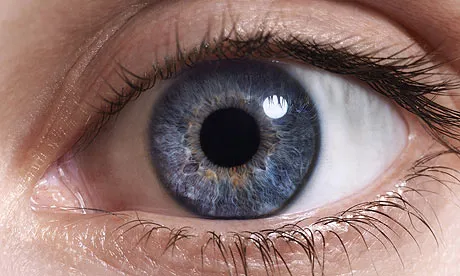
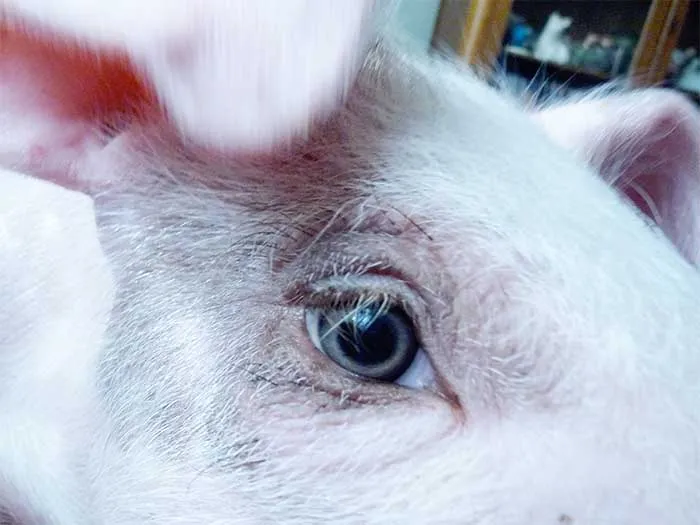
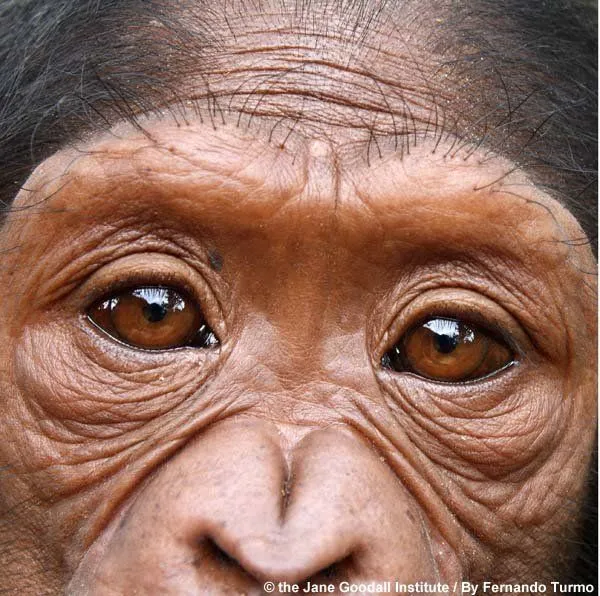
a protruding cartilaginous nose

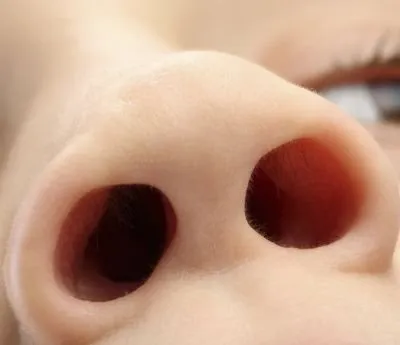
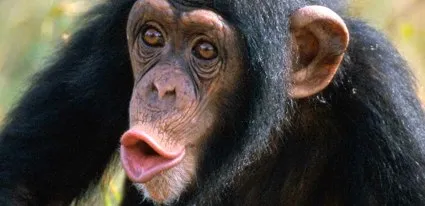
Hmmm, we don't quite look like a pig nose, but we definitely don't look like a Chimp nose
Some people are hairier then others, but a human that had the hair density of a chimpanzee would be extreme. We tend to be a lot more 'naked'. Most wild pigs also have quite a bit more hair then the domestic varieties. Maybe we're domesticated too? Who knows.
There are only two mammals on this planet with subcutaneous fat. Pigs, and humans. It's actually part of an incredible state of the art body temperature regulating system. Hunter-gatherer societies all across the world have made good use of this by doing their hunting in the heat of the day. Large game can't cool themselves off like we can, and it's a non-trivial but completely functional way of killing them, simply run them down in the heat until they collapse of heat exhaustion. The human system has no problem dissipating enough heat.
The backbone of our cooling system is how our blood vessels actually reach up through our adipose tissue, as opposed to running parallel to the skin like other Primates. In conjunction with our sweat glands, this system can shed massive amounts of heat. We may be one of the most functional long range athletic beings on the planet under high heat conditions. Ever felt inspired to sign up for a 135 mile ultra-marathon across death valley in mid July? With temperatures up to 130f, the roster is capped at 250 people and sells out months in advance! Don't forget to bring a pig, they happen to be the only other mammal on planet earth with the exact same system.
But guess who does?
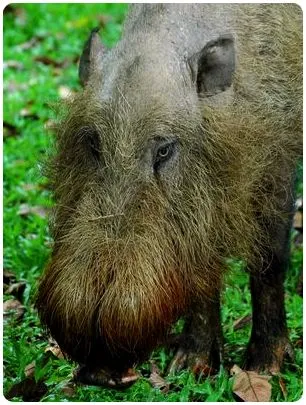
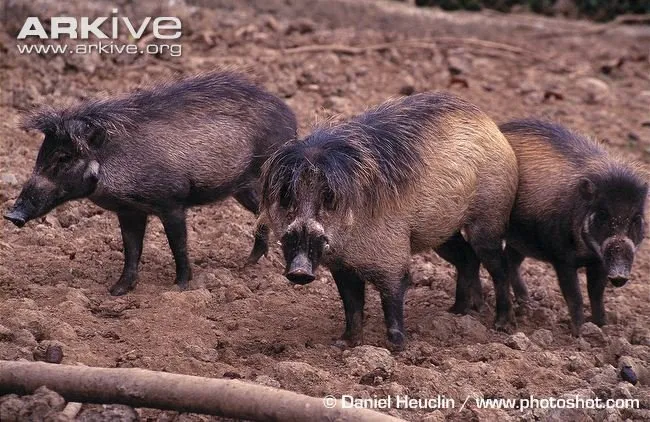

parasites are often quite specific about their hosts
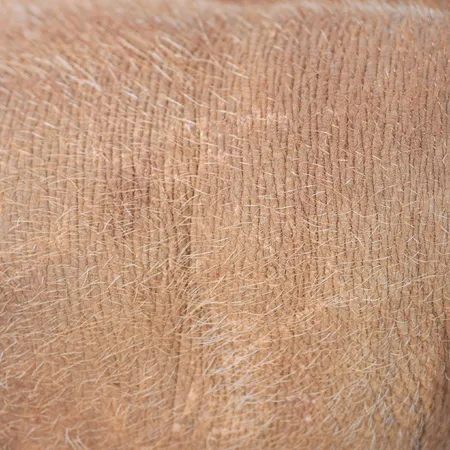
thats pig skin

that ones human
Pigs also have longer rear legs then their front
So female non-human primates definitely can orgasm in a laboratory environment? (I wonder if they're accepting interns!) It doesn't appear to be the norm, but it has happened. In the wild, it's a lot less clear, but the short ejaculation times of most primates suggests that its not common
Female pigs have orgasms(some accounts up to 30 minutes!). They also have both labias, which supposedly chimpanzees don't...I couldn't find any pictures online. Male pigs require anywhere from 5 to 25 minutes to copulate, compared to primate copulations which are measured in seconds. You can actually find tons of pictures of pig labias, but I think I'll let you do that on your own time.
This is an interesting one. We've all heard talk of how smart pigs are. But they don't have particularly large brains. But, neither do chimpanzees. It's often tempting to utilize a brain to body-mass ratio for comparison of brain sizes between animals, however one complication is that even this ratio becomes skewed by size of the animal. For instance, Mice have an incredibly high brain to body mass ratio, and elephants much lower, even though elephants are considered one of the most intelligent animals in the world.
To start lets look at other primates. Why haven't they evolved larger brains too? There's a number of theories on the subject. One interesting one is simply that brains are very energy intensive, they require a LOT of calories to run, by some estimates the human brain burns between 20% and 40% of all your caloric intake, even though it's only about 2% of your mass. An even more interesting, but less often discussed, piece to that theory is cooling. It's all about surface area and volume. It's the square cube law, a basic tenant of calculus.
The ratio of surface area to volume declines as the size of an object increases. A large object has a small surface area in proportion to its volume. If heat is flowing out of an object, the rate at which it passes out will be directly proportional to the object's surface area.
Square cube law -Wikipedia
This means that as a brain grows larger, it's proportional surface area is decreasing. The amount of energy required is growing linearly as we increase the mass of the brain, yet the surface area(it's ability to dissipate heat) is decreasing exponentially...this results in serious cooling troubles the larger you go. You see this perfectly in existing primates, the larger species brains seem to hit a 'cap', thus larger primates(gorillas, orangatangs, etc) brain size ratios taper off quickly compared to their smaller relatives. For what it's worth, scientists have only recently began to understand Elephant's thermo-regulative systems.
It has been well understood for decades that humans are strangely infertile compared to chimps (and most other mammals). And it's not just the appearance of sperm; a high percentage of human spermatozoa are totally dysfunctional (92 times higher than the percentage found in a Chimp). It would seem a difficult proposition to argue that this massive increase to infertility was actually the result of natural selection.
We use pig heart valves to replace ones damaged through heart disease. Pig skin is used in the case of burn victims. Serious efforts have been directed at using pig kidneys and other organs for transplants. Why not goats, dogs, or bears?
I believe it's worth pointing out that Occam's Razor has solid application here. For each such feature listed above in the content of this post, we would have to come up with a separate argument, supporting how the feature has helped both pigs and humans to survive and reproduce. On the other hand, a single, simple assumption (that modern humans, or earlier hominids that gave rise to modern humans, ultimately arose from a cross between pig and chimpanzee) will account for all of these features at a single stroke.
Wow. I know this is a lot of information, and probably brings up a few weird feelings too. So, as always, I would encourage you to look around you with your own eyes, do your own research. Don't believe everything that gets published by a major news network, or an independent scientist living in Georgia. You should read everything you can from all sources, and draw your own conclusions. Or don't. A wiser person than myself once told me
Good questions are hard to come by. When you find one, don't be in such a hurry to answer it.
- Martin Prechtel
or as any good programmer knows
Love your problems, not your solutions
After all, isn't Science at it's core just a method of questioning? In that spirit, I'd like to suggest you take this for what it is...simply some interesting observations that raise great questions.
I sincerely hope you have enjoyed thinking about them with me
-ItchyKitten